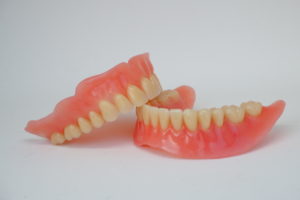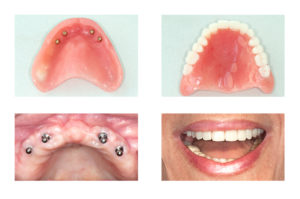How Implants Make Dentures Better
The History of Dentures
 More than 36 million Americans do not have any teeth. Unfortunately, this state, called edentulism, is nothing new. Teeth have been removed due to decay and gum disease for thousands of years. People have also been attempting to replace those missing teeth for thousands of years. There is historical evidence that dentures were made as far back as 700 BC! Contrary to popular belief, President George Washington’s dentures were not made from wood, but from a combination of carved ivory, human teeth and animal teeth.
More than 36 million Americans do not have any teeth. Unfortunately, this state, called edentulism, is nothing new. Teeth have been removed due to decay and gum disease for thousands of years. People have also been attempting to replace those missing teeth for thousands of years. There is historical evidence that dentures were made as far back as 700 BC! Contrary to popular belief, President George Washington’s dentures were not made from wood, but from a combination of carved ivory, human teeth and animal teeth.
The history of dentures has been a long, ever-changing one. Man has been attempting to improve “false teeth” for thousands of years. Most of these changes have been in the materials and techniques by which the dentures are made. In general, dentures have relied on the remaining jawbone for their only structural support. And as the jawbone continually changes in response to the absence of teeth, maintaining a proper fit with full dentures is a constant battle. Only in recent decades have we been able to give a full set of dentures something to anchor onto: Dental implants!
The Trouble With Dentures
A traditional full set of dentures has a large acrylic base that holds the false teeth. This base simply rests on the gums and jawbone remaining in the mouth after all of the teeth have been extracted. The gum and jawbone remaining after the teeth are pulled are called the alveolar ridge. The upper and lower jawbones are unique in that their only purpose is to support teeth. Once teeth are removed, the bone shrinks and recedes because it no longer has anything to hold onto. This process happens slowly over a period of years. As the ridge shrinks, there is less and less for the denture to sit on, so dentures become increasingly loose and difficult to wear. Some people are able to adapt to full dentures and use the muscles in their cheeks, lips and tongue to hold them in place while eating and talking. However, many people are not able to achieve that level of muscle control and struggle to keep their dentures in place, often suffering difficulty chewing, and embarrassment when talking or laughing.
Better Dentures
The solution for this worsening problem with ill-fitting dentures is dental implants. Dental implants improve dentures in two different ways.
- The root form: Dental implants are placed into the jawbone and function similarly to a natural tooth root. The jawbone responds to an implant the way it would to a tooth root and does not shrink in height or width. The dental implant acts to maintain the jawbone, giving the denture more surface area of the alveolar ridge to rest on, which is less likely to shrink and change over time.
- The abutment: The abutment is the portion of the dental implant system that projects out of the gum tissue. Abutments come in many shapes in sizes, depending on their purpose. For the purpose of denture retention, a locator abutment is placed into the implant root form. The denture contains a cap set into the denture acrylic base for each locator abutment in the jawbone. There is a range of caps available, giving you and your dentist flexibility in how tightly your denture locks onto the locator abutment. Because of this locking action, the dentures do not move when you chew or talk!

This is a vast improvement from traditional dentures, which depend on a person’s muscles to hold them in place. In this scenario, rather than having an acrylic denture base which simply fits over the gums, there are interlocking pieces on both the implant and the denture, creating a secure connection. This connection eliminates the embarrassment and fear that plagues traditional denture wearers.
Implant-Supported Dentures
 At Designer Smiles, Dr. Ann and Dr. Lauren place dental implants, which are used to support dentures, using the same three-dimensional technology used for a single-tooth replacement implant. It begins with 3D imaging for preoperative planning. The images are used to prescribe the exact location for the implants. Then a surgical guide can be made from these digital images so that your dentist can translate the prescribed location of each implant into reality during surgical placement. This preoperative planning gives the most predictable, successful long-term results for both the implants themselves and the denture they will support.
At Designer Smiles, Dr. Ann and Dr. Lauren place dental implants, which are used to support dentures, using the same three-dimensional technology used for a single-tooth replacement implant. It begins with 3D imaging for preoperative planning. The images are used to prescribe the exact location for the implants. Then a surgical guide can be made from these digital images so that your dentist can translate the prescribed location of each implant into reality during surgical placement. This preoperative planning gives the most predictable, successful long-term results for both the implants themselves and the denture they will support.
Once the surgical phase is complete, and the implants have achieved adequate stability to withstand chewing forces, Dr. Ann and Dr. Lauren will fabricate dentures with appropriate attachments to connect securely with your implants. With implant-supported dentures, any adjustment period is much shorter due to the security and stability of the implant-denture connection. This creates a level of function far superior to any achieved by traditional dentures. Patients are more comfortable and more confident with implant-supported dentures.
Do You Have Poorly Fitting Dentures?
If you are interested in implant-supported dentures, call our office at 281-667-4010 to set up a consultation with Dr. Ann and Dr. Lauren.
